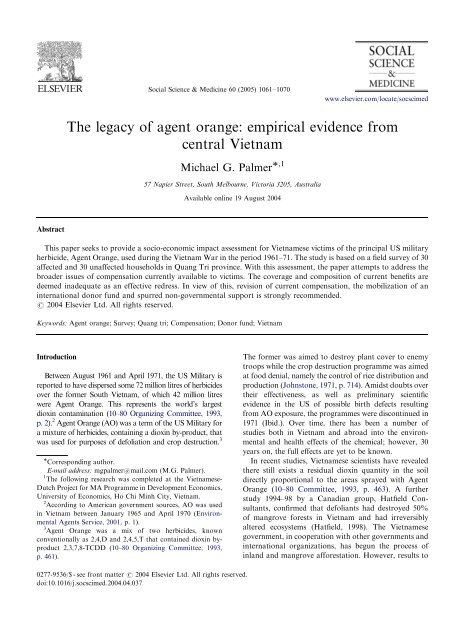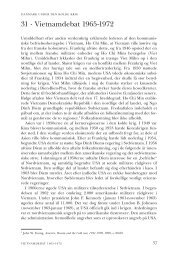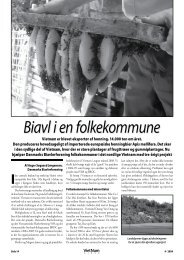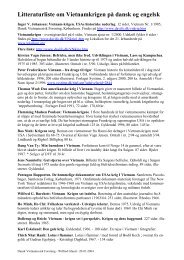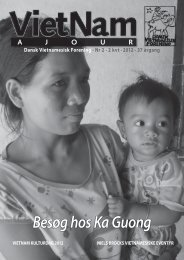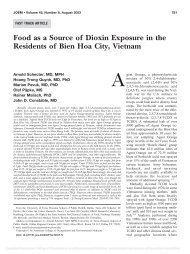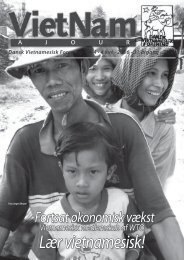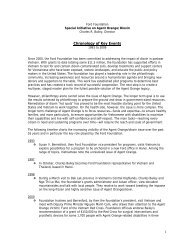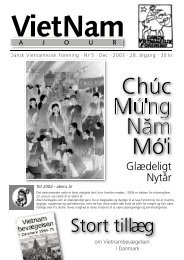The legacy of agent orange: empirical evidence from central Vietnam
The legacy of agent orange: empirical evidence from central Vietnam
The legacy of agent orange: empirical evidence from central Vietnam
Create successful ePaper yourself
Turn your PDF publications into a flip-book with our unique Google optimized e-Paper software.
ARTICLE IN PRESS<br />
Social Science & Medicine 60 (2005) 1061–1070<br />
www.elsevier.com/locate/socscimed<br />
<strong>The</strong> <strong>legacy</strong> <strong>of</strong> <strong>agent</strong> <strong>orange</strong>: <strong>empirical</strong> <strong>evidence</strong> <strong>from</strong><br />
<strong>central</strong> <strong>Vietnam</strong><br />
Michael G. Palmer ,1<br />
57 Napier Street, South Melbourne, Victoria 3205, Australia<br />
Available online 19 August 2004<br />
Abstract<br />
This paper seeks to provide a socio-economic impact assessment for <strong>Vietnam</strong>ese victims <strong>of</strong> the principal US military<br />
herbicide, Agent Orange, used during the <strong>Vietnam</strong> War in the period 1961–71. <strong>The</strong> study is based on a field survey <strong>of</strong> 30<br />
affected and 30 unaffected households in Quang Tri province. With this assessment, the paper attempts to address the<br />
broader issues <strong>of</strong> compensation currently available to victims. <strong>The</strong> coverage and composition <strong>of</strong> current benefits are<br />
deemed inadequate as an effective redress. In view <strong>of</strong> this, revision <strong>of</strong> current compensation, the mobilization <strong>of</strong> an<br />
international donor fund and spurred non-governmental support is strongly recommended.<br />
r 2004 Elsevier Ltd. All rights reserved.<br />
Keywords: Agent <strong>orange</strong>; Survey; Quang tri; Compensation; Donor fund; <strong>Vietnam</strong><br />
Introduction<br />
Between August 1961 and April 1971, the US Military is<br />
reported to have dispersed some 72 million litres <strong>of</strong> herbicides<br />
over the former South <strong>Vietnam</strong>, <strong>of</strong> which 42 million litres<br />
were Agent Orange. This represents the world’s largest<br />
dioxin contamination (10–80 Organizing Committee, 1993,<br />
p. 2). 2 AgentOrange(AO)wasaterm<strong>of</strong>theUSMilitaryfor<br />
a mixture <strong>of</strong> herbicides, containing a dioxin by-product, that<br />
was used for purposes <strong>of</strong> defoliation and crop destruction. 3<br />
Corresponding author.<br />
E-mail address: mgpalmer@mail.com (M.G. Palmer).<br />
1 <strong>The</strong> following research was completed at the <strong>Vietnam</strong>ese-<br />
Dutch Project for MA Programme in Development Economics,<br />
University <strong>of</strong> Economics, Ho Chi Minh City, <strong>Vietnam</strong>.<br />
2 According to American government sources, AO was used<br />
in <strong>Vietnam</strong> between January 1965 and April 1970 (Environmental<br />
Agents Service, 2001, p. 1).<br />
3 Agent Orange was a mix <strong>of</strong> two herbicides, known<br />
conventionally as 2,4,D and 2,4,5,T that contained dioxin byproduct<br />
2,3,7,8-TCDD (10–80 Organizing Committee, 1993,<br />
p. 461).<br />
<strong>The</strong> former was aimed to destroy plant cover to enemy<br />
troops while the crop destruction programme was aimed<br />
at food denial, namely the control <strong>of</strong> rice distribution and<br />
production (Johnstone, 1971, p. 714). Amidst doubts over<br />
their effectiveness, as well as preliminary scientific<br />
<strong>evidence</strong> in the US <strong>of</strong> possible birth defects resulting<br />
<strong>from</strong> AO exposure, the programmes were discontinued in<br />
1971 (Ibid.). Over time, there has been a number <strong>of</strong><br />
studies both in <strong>Vietnam</strong> and abroad into the environmental<br />
and health effects <strong>of</strong> the chemical; however, 30<br />
years on, the full effects are yet to be known.<br />
In recent studies, <strong>Vietnam</strong>ese scientists have revealed<br />
there still exists a residual dioxin quantity in the soil<br />
directly proportional to the areas sprayed with Agent<br />
Orange (10–80 Committee, 1993, p. 463). A further<br />
study 1994–98 by a Canadian group, Hatfield Consultants,<br />
confirmed that defoliants had destroyed 50%<br />
<strong>of</strong> mangrove forests in <strong>Vietnam</strong> and had irreversibly<br />
altered ecosystems (Hatfield, 1998). <strong>The</strong> <strong>Vietnam</strong>ese<br />
government, in cooperation with other governments and<br />
international organizations, has begun the process <strong>of</strong><br />
inland and mangrove afforestation. However, results to<br />
0277-9536/$ - see front matter r 2004 Elsevier Ltd. All rights reserved.<br />
doi:10.1016/j.socscimed.2004.04.037
ARTICLE IN PRESS<br />
1062<br />
M.G. Palmer / Social Science & Medicine 60 (2005) 1061–1070<br />
date have been modest due to a shortage <strong>of</strong> manpower<br />
and funds (10–80 Committee, 1993, p. 465). It was<br />
estimated that in order to cover the forest area destroyed<br />
it would take many more decades, perhaps even a<br />
century with industrious labour and a steady supply <strong>of</strong><br />
international funding.<br />
In terms <strong>of</strong> the human health effects, an early study by<br />
<strong>Vietnam</strong>ese scientists in cooperation with a New Yorkbased<br />
scientist showed disproportionately high levels <strong>of</strong><br />
dioxin in the blood <strong>of</strong> residents in southern sprayed<br />
areas compared to a number <strong>of</strong> control groups in the<br />
north (10–80 Committee, 1993, pp. 5–8). As recently as<br />
1995, dioxin blood levels were found to be between 25<br />
and 170 times higher in sprayed villages than in northern<br />
villages (Cayo, 2000). Meanwhile, in the US the<br />
National Academy <strong>of</strong> Sciences has set out a list <strong>of</strong><br />
diseases that are found to have ‘‘sufficient’’ <strong>evidence</strong> or<br />
‘‘suggestive’’ <strong>evidence</strong> <strong>of</strong> an association to AO (Institute<br />
<strong>of</strong> Medicine, 2000). Updated in 2000, these include<br />
sufficient <strong>evidence</strong> <strong>of</strong> s<strong>of</strong>t-tissue sarcoma, non-Hodgkins<br />
lymphoma, Hodgkin’s disease and chloracne, and<br />
suggestive <strong>evidence</strong> <strong>of</strong> respiratory cancers (lung,<br />
bronchus, larynx, trachea), prostate cancer, multiple<br />
myeloma, acute and subacute transient peripheral<br />
neuropathy, porphyria cutanea tarda, type 2 diabetes,<br />
spina bifida and acute myelogenous leukemia in the<br />
children <strong>of</strong> veterans. In the US some 300,000 veterans<br />
have undergone medical tests and an estimated 2000<br />
children are potentially suffering <strong>from</strong> the birth defect<br />
spina bifida (Veteran Affairs, 2000, p. 4,8). Meanwhile<br />
in <strong>Vietnam</strong> preliminary research estimates 1 million first,<br />
second and third generation victims <strong>of</strong> AO (<strong>Vietnam</strong><br />
News, 2001a). Of these, 50,000 deformed children are<br />
believed to have been born to parents exposed either by<br />
location or though access to sprayed foodstuff (<strong>Vietnam</strong><br />
Investment Review, 2000). In some villages one in every<br />
10 children suffers serious birth defect such as spina<br />
bifida, celebral palsy, physical and or mental retardation,<br />
missing or deformed limbs (Satchell, 1999). <strong>The</strong> full<br />
extent <strong>of</strong> the problem, however, remains unknown.<br />
Current estimates are based on a National Health<br />
Survey that was begun in 1999 as a preliminary register<br />
<strong>of</strong> persons who reported or displayed any possible AOassociated<br />
diseases. It is very possible that the social<br />
stigma attached to AO-affected persons could have<br />
cautioned them (especially unmarried men and women)<br />
<strong>from</strong> an open disclosure in the survey. Furthermore,<br />
prospects <strong>of</strong> benefits may have led others to claim<br />
diseases without blood testing and medical verification.<br />
At a quoted $2000 per person, blood testing for<br />
supernormal levels <strong>of</strong> dioxin continues slowly (Mai<br />
Phuong, 2001). 4 More recent government estimates put<br />
4 Note the American government does not test American<br />
veterans for dioxin on the basis <strong>of</strong> the National Academy <strong>of</strong><br />
Science’s finding in 1993 that results are not usually meaningful<br />
numbers at 3 million while a Columbia University study<br />
estimates up to 4 million persons may be directly<br />
affected by AO (Tran Dinh Thanh Lam, 2004; Stellman,<br />
Stellman, Christian, Weber, & Tomasallo, 2003).<br />
<strong>The</strong> use <strong>of</strong> Agent Orange in the <strong>Vietnam</strong> War is<br />
allegedly a war crime. A lack <strong>of</strong> political resolve on the<br />
part <strong>of</strong> governments, and a lack <strong>of</strong> accessible judicial<br />
forums for individuals, has, however, resulted in few<br />
legal actions for the compensation <strong>of</strong> victims (Palmer,<br />
2004). Since the US government cannot be sued without<br />
its consent, all civil action to date has instead proceeded<br />
against US companies involved in the manufacture <strong>of</strong><br />
AO. In 1984, a class action lawsuit brought by American<br />
and Australian veterans resulted in a settlement <strong>of</strong> $180<br />
million that extended only to veterans with death or<br />
total disability claims (Smoger, 1993 in 10–80 Committee,<br />
1993, p. 458). In <strong>Vietnam</strong>, it was only in January<br />
2004 that the first suit was filed by three victims against<br />
several dozen US companies including Dow Chemical<br />
and Monsanto, in a New York district court (Agence<br />
France Press (2004); Kokkoris, Moore, & Goodman,<br />
2004). Compensation has thus for the most part relied<br />
on domestic mechanisms. In the US, subsequent to the<br />
Agent Orange Act <strong>of</strong> 1991, any veteran who served<br />
however briefly in <strong>Vietnam</strong> and is suffering <strong>from</strong> any <strong>of</strong><br />
the above-listed National Academy <strong>of</strong> Science AOassociated<br />
diseases with at least 10% disability are<br />
entitled to compensation <strong>from</strong> the Department for<br />
Veteran Affairs. Compensation consists <strong>of</strong> payments<br />
rated according to disability ($98 per month for a<br />
veteran with 10% rating to $2036 for a 100% rating),<br />
hospital care and medical services, and the possible<br />
provision <strong>of</strong> nursing home care (Veteran Affairs, 2000,<br />
p. 3). Children are eligible for vocational training<br />
support if suffering <strong>from</strong> spina bifida. While the<br />
American government is required by law to compensate<br />
American or <strong>Vietnam</strong>ese-Americans living on its soil it<br />
has yet to compensate victims in <strong>Vietnam</strong>. In 1997, the<br />
US Ambassador to <strong>Vietnam</strong> questioned the availability<br />
<strong>of</strong> scientific <strong>evidence</strong> to establish the ‘‘exact consequences<br />
<strong>of</strong> Agent Orange’’ (Ha Thang, 1997). In early<br />
2000, the <strong>Vietnam</strong>ese government formally introduced<br />
the AO Central Payments Programme. Compensation<br />
consists <strong>of</strong> monthly payments ranging <strong>from</strong> $3.40 to<br />
$7.14 for adults and children who have partially or<br />
totally lost the ability to work (<strong>Vietnam</strong> Investment<br />
Review, 2000). As in the US programme, compensation<br />
is only extended to children suffering <strong>from</strong> the condition<br />
<strong>of</strong> spina bifida and furthermore includes orphans <strong>of</strong><br />
deceased persons as a result <strong>of</strong> AO-associated diseases;<br />
however, the US programme includes spouses and<br />
(footnote continued)<br />
due to common background exposures, variations amongst<br />
individuals, and possible measurement errors and exposure to<br />
other herbicides (Environmental Agents Service, 2001, p. 2).
ARTICLE IN PRESS<br />
M.G. Palmer / Social Science & Medicine 60 (2005) 1061–1070 1063<br />
dependent parents as well as children. Under the<br />
<strong>Vietnam</strong> programme, no provision is made for nonmonetary<br />
benefits except for humanitarian center<br />
assistance and medical treatment for orphans. To<br />
remedy this, the <strong>Vietnam</strong> Red Cross Society Fund was<br />
established in 1998 with donations <strong>from</strong> societies in<br />
Denmark, the US, Switzerland and other international<br />
organizations to provide treatment and rehabilitation,<br />
literacy and vocational training programmes and<br />
monetary support for victims in selected provinces<br />
(<strong>Vietnam</strong> News, 2001a, p. 7). Meanwhile, other nongovernmental<br />
and inter-governmental support has been<br />
largely area based and non-specific to AO.<br />
Government and international donors have thus<br />
recently tried to address the issue <strong>of</strong> compensation but<br />
there are no studies to quantify the socio-economic costs<br />
borne by individuals affected by AO in <strong>Vietnam</strong>. This<br />
paper, therefore, attempts first to provide a preliminary<br />
assessment <strong>of</strong> the social and economic costs <strong>of</strong> victims<br />
(including loss <strong>of</strong> income, increase in resources devoted<br />
to medical expenses, educational and marital attainments)<br />
and, second, to review the current mechanisms <strong>of</strong><br />
compensation available to victims. <strong>The</strong> findings <strong>of</strong> the<br />
paper are based on a field survey <strong>of</strong> 30 affected and 30<br />
unaffected households in Quang Tri province in May<br />
2001. Section two outlines the survey site and representation<br />
<strong>of</strong> affected and unaffected households and<br />
section three summarizes the methodology adopted for<br />
socio-economic assessment. <strong>The</strong> fourth section presents<br />
the results <strong>of</strong> the survey and is followed up with a review<br />
<strong>of</strong> current compensation in terms <strong>of</strong> coverage and<br />
composition. A concluding note and suggestions for<br />
further research complete the paper.<br />
<strong>The</strong> survey site and representation<br />
Table 1<br />
Agent <strong>orange</strong> flying missions and quantity by locality<br />
Provincial locality Missions Quantity<br />
no.<br />
(l/ha)<br />
Tay Ninh 334 21007<br />
Ma Da (Tri An) 507 19206<br />
Song Be 246 17693<br />
A Loi 271 14737<br />
Hue 196 6964<br />
Quang Tri 0 6602<br />
Giong Trom (Ben Tre) 115 4384.5<br />
Bac Lieu 35 3191.7<br />
Bien Hoa 38 2609<br />
Ho Chi Minh City 73 2423<br />
Tra Vinh 35 1332.2<br />
Co Quao (Rach Gia) 20 485<br />
Da Nang 8 185<br />
Source: 10–80 Organizing Committee, 1993, Ministry <strong>of</strong> Health,<br />
Ministry <strong>of</strong> Science, Technology and Environment, <strong>The</strong> II<br />
International Conference on Herbicides in War—‘‘<strong>The</strong> Long<br />
Term Effects on Man and Nature’’, Final Report, Hanoi, 15–18<br />
November 1994, p. 15 (figures are aggregate for 30 and 10 km<br />
radius).<br />
<strong>Vietnam</strong>ese sources have recorded the spraying <strong>of</strong> AO<br />
10 and 30 km <strong>from</strong> the center <strong>of</strong> defined localities in the<br />
then South <strong>Vietnam</strong> (10–80 Organizing Committee,<br />
1993, p. 15). It is reported that only 4 and 1 localities<br />
were exempt <strong>from</strong> spraying to this degree (10–80<br />
Organizing Committee, 1993, p. 7). Sprayed localities<br />
are listed in Table 1 with details on the number <strong>of</strong> flying<br />
missions and quantity <strong>of</strong> AO sprayed.<br />
Quang Tri province was chosen as an upper middle<br />
sprayed proxy for total sprayed areas with a reported<br />
150 flying missions and quantity <strong>of</strong> 6602 l/hectare.<br />
Quang Tri borders the demilitarized zone along the<br />
17th parallel that once divided the north <strong>from</strong> the south<br />
and represents one <strong>of</strong> the most heavily AO-exposed<br />
regions in the country (<strong>Vietnam</strong> Investment Review,<br />
1999). According to the 1999 National Health Survey, <strong>of</strong><br />
a population <strong>of</strong> 576,666 the province is home to 15,000<br />
persons affected by AO, <strong>of</strong> which 5240 are children<br />
suffering <strong>from</strong> birth defects (<strong>Vietnam</strong> Investment Review,<br />
1999). Within the province <strong>of</strong> Quang Tri there are<br />
nine districts and 136 communes, which contain any<br />
number <strong>of</strong> villages (Quang Tri Statistical Office, 2000).<br />
<strong>The</strong> two districts <strong>of</strong> Gio Linh and Cam Lo were<br />
identified as accessible, yet separate, AO-sprayed areas<br />
with a reported AO-affected population. Within Gio<br />
Linh and Cam Lo districts there are 20 and nine<br />
communes, respectively. For each district, single communes,<br />
Gio Mai and Cam Thuy, respectively, were<br />
chosen on the basis <strong>of</strong> their similarities with Quang Tri<br />
in terms <strong>of</strong> population size and characteristics. 5 <strong>The</strong>se<br />
communes, Gio May, Gio Linh district and Cam Thuy,<br />
Cam Lo district are marked on the map as known AOsprayed<br />
areas. Within each commune the same selection<br />
criteria were applied to select the final two villages for<br />
survey (Charts 1 and 2).<br />
Whilst we are primarily interested in measuring the<br />
costs borne by individuals affected by AO, data were<br />
collected at the household level and later appropriated<br />
per capita because the majority <strong>of</strong> workers were farmers<br />
whose income (and <strong>of</strong>ten medical expenses) was pooled<br />
amongst family members. 6 Given that the affected<br />
5 Based on the above statistics, approximately 2.6% <strong>of</strong> the<br />
Quang Tri population is AO-affected. Gio Mai commune in<br />
Gio Linh district has a reported population <strong>of</strong> 4667 persons <strong>of</strong><br />
which 2.8% are AO-affected while Cam Thuy commune in Cam<br />
Lo district has a population <strong>of</strong> 4608 and 2.1% affected persons.<br />
6 Survey statistics indicate that in both communes around<br />
70% <strong>of</strong> households derived their main income <strong>from</strong> farming,<br />
and in particular crops <strong>of</strong> rice, peanuts and cassava.
ARTICLE IN PRESS<br />
1064<br />
M.G. Palmer / Social Science & Medicine 60 (2005) 1061–1070<br />
Chart 1 & 2. Quang Tri Province.<br />
households (a household in which at least one member is<br />
affected) represent only 8% <strong>of</strong> the total population <strong>of</strong><br />
households in Gio Mai and Cam Thuy communes, to<br />
select randomly <strong>from</strong> the total population <strong>of</strong> households<br />
would have necessitated a very large sample to<br />
adequately represent affected households. A disproportionate<br />
stratified systematic sample method was consequently<br />
adopted where the population was divided into<br />
affected and unaffected strata and a survey <strong>of</strong> every Xth<br />
household taken <strong>from</strong> the given population list (Sapsford,<br />
1996, pp. 33–34). 7 With an affected household<br />
population proportion <strong>of</strong> 9.63% in Gio Mai commune<br />
and 6.3% in Cam Thuy commune, adequate representation<br />
<strong>of</strong> affected households was estimated at 18 and 12<br />
households, respectively. 8 An equal control group <strong>of</strong> 30<br />
unaffected households provided the basis for comparison.<br />
To stand up against affected households these<br />
households were ensured to have had an equal exposure<br />
to AO and similar demographics to that <strong>of</strong> affected<br />
households. For instance, it may have been possible that<br />
survey respondents had immigrated to the region <strong>from</strong><br />
other provinces and thus were not directly exposed to<br />
AO. Or, it may have been possible that unaffected<br />
households simply had more household members, and<br />
7 Note this method is adequate in this case where the order <strong>of</strong><br />
household lists were alphabetic and therefore did not display<br />
any patterns that may lead to a bias.<br />
8 <strong>The</strong> precision <strong>of</strong> sample estimates has been found to depend<br />
much on the sample size and little on the size <strong>of</strong> the population<br />
sampled (Sapsford, 1996, p. 49). Statistical techniques allow us<br />
to balance the costs <strong>of</strong> surveying against the level <strong>of</strong> precision<br />
required or standard error, as given by the following sample size<br />
formula: n ¼ pð1 pÞ=½SMŠ 2 where n denotes sample size, p is<br />
the population proportion and SM the standard error (0.13/<br />
1.96) (Moser, 1971, p. 147). In the case <strong>of</strong> affected strata in both<br />
communes, an interval range <strong>of</strong> 13 percentage points was<br />
allowed under a degree <strong>of</strong> confidence <strong>of</strong> 95%.<br />
therefore labourers, or alternatively, access to employment<br />
that kept them away <strong>from</strong> the AO-contaminated<br />
land. <strong>The</strong>refore, all unaffected households selected had a<br />
tenancy status <strong>of</strong> at least 30 years. Furthermore, in terms<br />
<strong>of</strong> demographics, average members per household for<br />
affected and unaffected were 4.2 and 4.7, respectively,<br />
and average age per capita at 31 and 26 years,<br />
respectively. In both cases over two-thirds <strong>of</strong> family<br />
members worked as self-employed farmers.<br />
Since the affected stratum is <strong>of</strong> most interest, it was<br />
necessary to increase the proportion <strong>of</strong> the sample taken<br />
in the population to a level disproportionate with the<br />
unaffected strata. This is indicated in Table 2 with<br />
affected households representing 18.86% <strong>of</strong> the population<br />
compared to 1.63% for unaffected households. To<br />
bring the sample data back into line with the true<br />
population proportions, population weights were applied<br />
to the following estimates. <strong>The</strong> result is that only<br />
3% <strong>of</strong> the total population was surveyed where each<br />
affected and unaffected household stands as a reasonable<br />
proxy for an equal number <strong>of</strong> households in each<br />
population.<br />
Methodology <strong>of</strong> socio-economic impact assessment<br />
<strong>The</strong> subsequent result estimates are henceforth<br />
generated <strong>from</strong> Vo’s (2001) survey <strong>of</strong> 30 households<br />
affected by an exposure to AO and a control group <strong>of</strong> 30<br />
unaffected households, across four villages in Gio Mai<br />
commune, Gio Linh district, and Cam Thuy commune,<br />
Cam Lo district, Quang Tri province. Analysis is<br />
provided <strong>of</strong> the real costs <strong>of</strong> illness in the form <strong>of</strong> lost<br />
productivity and output and the increase in resources<br />
devoted to medical care, together with effects on years <strong>of</strong><br />
education and marital status <strong>of</strong> affected households
ARTICLE IN PRESS<br />
M.G. Palmer / Social Science & Medicine 60 (2005) 1061–1070 1065<br />
Table 2<br />
Survey representation, Gio Linh and Cam Lo districts, Quang Tri Province<br />
Subgroups Affected Unaffected Total no.<br />
No. % No. %<br />
Households<br />
Survey 30 50 30 50 60<br />
Population 159 7.97 1836 92.03 1995<br />
% 18.86 1.63 3<br />
People<br />
Survey 37 20.90 140 79.10 177<br />
Population 229 2.46 9066 97.54 9295<br />
% 16.16 1.54 1.90<br />
Source: Vo Xuan Hong, 2001, ‘‘Household Survey Data Bank, Gio Linh and Cam Lo districts, Quang Tri province, May 2001’’, Ho<br />
Chi Minh City: University <strong>of</strong> Economics.<br />
compared to the control group <strong>of</strong> unaffected households.<br />
Averages per capita per annum <strong>of</strong> earnings<br />
(income), medical expenses and years <strong>of</strong> education <strong>of</strong><br />
affected households are compared to that <strong>of</strong> unaffected<br />
households. 9<br />
Household income was collected according to the<br />
<strong>Vietnam</strong> Living Standards Survey 1997–1998 to include<br />
<strong>of</strong>f-farm and on-farm income. Off-farm income was<br />
divided into sources <strong>from</strong> salaries, pensions, wages/self<br />
collected, self-employment and other transfers (including<br />
<strong>from</strong> relatives, local and/or national government).<br />
On-farm income was split between crops (rice, peanuts,<br />
sweet potato, red pepper and cassava) and livestock<br />
(pigs, chicken and duck) income. In each case, income<br />
was taken as total revenueless expenditure.<br />
Medical expenses were collected as the sum <strong>of</strong><br />
household hospital, local clinic, private doctor, traditional<br />
medicine and self-treatment expenditure per<br />
annum. Medical expenses range <strong>from</strong> tiered public<br />
services <strong>of</strong> <strong>central</strong>, district and provincial hospitals and<br />
commune health centers (Donor Working Group on<br />
Public Expenditure Review., 1999, p. 48). Private health<br />
services extend in descending order <strong>of</strong> usage to drug<br />
commission sellers, general practitioners’ clinics, traditional<br />
medicine clinics, and nursing homes. Also <strong>of</strong><br />
consideration is the possible eligibility <strong>of</strong> AO victims to<br />
income and medical benefits <strong>from</strong> social assistance<br />
programmes, most fittingly, the <strong>Vietnam</strong> Health Insurance<br />
scheme and the Social Protection Fund for Regular<br />
Relief. 10<br />
9 Debate exists over the choice <strong>of</strong> income or household<br />
consumption as a measure <strong>of</strong> living standards; however, income<br />
was chosen on practical grounds <strong>of</strong> ease <strong>of</strong> measurement (see<br />
Deaton, 1997, pp. 148–151).<br />
10 <strong>The</strong> <strong>Vietnam</strong> Health Insurance programme entitles users to<br />
public health facilities and the Social Protection Fund for<br />
Regular Relief provides regular monthly benefits to three<br />
As mentioned, a practical difficulty arose in attributing<br />
individual contributions to income and medical<br />
expenses and hence apportioning individual loss. This is<br />
especially the case in the four villages surveyed where<br />
pooled on-farm income represented the main source <strong>of</strong><br />
income. Since the data was collected at the household<br />
level it was necessary to transform it to a per capita<br />
basis. 11 While statistical advances have attempted to<br />
construct weights that are theoretically appropriate to<br />
children, they are yet to yield widespread approval<br />
(Deaton, 1997, pp. 150–151). Equal weightings are here<br />
attached to adults and children.<br />
<strong>The</strong> following results were derived <strong>from</strong> affected<br />
households identified in the National Health Survey<br />
which commenced in June 1999. <strong>The</strong> survey exists as a<br />
register <strong>of</strong> persons potentially affected by AO with<br />
diseases categorized to those able and unable to work.<br />
While enlisting diseases and disabling effects, the survey<br />
was not able to verify an exposure to AO and the alleged<br />
diseases <strong>of</strong> respondents. Respondents who reported or<br />
displayed any possible AO-associated diseases were<br />
short-listed to be later blood tested. In Vo’s survey <strong>of</strong><br />
May 2001, 25 out <strong>of</strong> the 37 affected persons surveyed<br />
had been positively blood tested for supernormal levels<br />
<strong>of</strong> dioxin but were yet to receive medical verification <strong>of</strong><br />
diseases.<br />
<strong>The</strong> other consideration, subject to the <strong>Vietnam</strong>ese<br />
government AO Central Payments Programme for the<br />
year 2000, is the possibility <strong>of</strong> surveying survivors <strong>of</strong><br />
deceased persons <strong>from</strong> AO-associated diseases. While<br />
their eligibility is not in question, such households form<br />
(footnote continued)<br />
groups <strong>of</strong> beneficiaries including the elderly, disabled and<br />
homeless (Donor Working Group on Public Expenditure<br />
Review., 1999, p. 79, pp. 83–84).<br />
11 Simply by dividing the total value by the number <strong>of</strong><br />
members <strong>of</strong> the household.
ARTICLE IN PRESS<br />
1066<br />
M.G. Palmer / Social Science & Medicine 60 (2005) 1061–1070<br />
Table 3<br />
Gini-coefficent and average income and medical expenses for affected households able/unable to work and study and unaffected<br />
households<br />
Subgroups (households) Affected (x 2 ) Unaffected (x 1 ) t-stat a<br />
Able Unable Total Mean Gini-coefficient Mean<br />
Variable Mean Mean Gini-coefficient<br />
Income per capita ($ p.a.) 41.69 30.48 0.46 33.93 0.48 65.86 3.74<br />
Medical expenditure per capita ($ p.a.) 10.65 13.26 0.35 12.40 0.41 9.47 1.83<br />
Education per capita (years) 5.34 5.16 0.18 5.22 0.23 5.81 1.34<br />
t(54)ffi71.6723, po0.10.<br />
1USD:15650VND.<br />
Source: author’s calculation<br />
p<br />
based on Vo (2001).<br />
a t ¼ðx 1 x 2 Þ= ffiffiffiffiffiffiffiffiffiffiffiffiffiffiffiffiffiffiffiffiffiffiffiffiffiffiffiffiffiffiffi<br />
s 2 ð1=n 1 þ 1=n 2Þ .<br />
a separate category and the information networks<br />
required to access them were not available in this<br />
context and are therefore excluded <strong>from</strong> this survey.<br />
Assessment is thus reduced to income and medical<br />
expenses per capita per annum and years <strong>of</strong> education<br />
per capita for the categories <strong>of</strong> (i) affected persons able<br />
to work and study (ii) affected persons unable to work<br />
or study.<br />
Results<br />
Of affected persons surveyed, 60% were adults <strong>of</strong><br />
which over half (52%) were unable to work or study. 12<br />
Of children surveyed, a similar proportion <strong>of</strong> 50% were<br />
unable to work or study. Greater than 40% <strong>of</strong> affected<br />
persons had zero education and 71% over the marriageable<br />
age <strong>of</strong> eighteen years were single. Affected households<br />
were found on average to have just under one half<br />
annual income per capita, and 31% greater medical<br />
expenditures per capita than unaffected households.<br />
<strong>The</strong>y were also found to have lower within-group<br />
inequality <strong>of</strong> income and medical expenses than<br />
unaffected households as reflected by lower Ginicoefficients.<br />
When asked about coping mechanisms for<br />
major medical expenses, 28% <strong>of</strong> households reported<br />
that they sold productive assets <strong>of</strong> land or cattle, 18%<br />
borrowed <strong>from</strong> relatives or friends and 12% reduced<br />
their food intake. Others relied on savings, credit and or<br />
government support. Over 96% <strong>of</strong> households said that<br />
if they were to receive more income they would spend it<br />
on health care (Table 3).<br />
When we break down affected households into those<br />
able and unable to work or study, the inequalities are<br />
even greater. Affected individuals with no capacity to<br />
12 Persons unable to work were taken as those equal to or<br />
above 18 years unable to undertake regular full time employment<br />
on or <strong>of</strong>f the farm.<br />
work or study had, on average, an annual income that<br />
was less than half, 40% greater medical costs and 11%<br />
less education (years) per capita than unaffected households.<br />
Compared to affected individuals able to work or<br />
study, those unable had on average over a quarter less<br />
income and near a quarter more medical expenses.<br />
Whereas affected individuals able to work experienced<br />
on average over a third less income (37%), 12% greater<br />
medical expenditures, and 8% less education per person<br />
per year than unaffected households. It is worthy to note<br />
that the overall effect <strong>of</strong> AO on education was found to<br />
be statistically significant. <strong>The</strong>refore based on this<br />
preliminary data, the incidence <strong>of</strong> an AO-associated<br />
disease, on average, has marginal effects on years <strong>of</strong><br />
schooling. <strong>The</strong> overall low level <strong>of</strong> education in the areas<br />
surveyed could potentially explain this as may the fact<br />
that over two-thirds <strong>of</strong> all households surveyed were in<br />
on-farm employment. Thus it could be said that levels <strong>of</strong><br />
education had a limited effect on employment opportunities.<br />
Whilst this is the general picture, there is some<br />
<strong>evidence</strong> that AO-affected households had less opportunity<br />
for <strong>of</strong>f-farm employment with 17% <strong>of</strong> unaffected<br />
households in public sector jobs compared to just 4%<br />
for affected households.<br />
Review <strong>of</strong> current compensation<br />
Presently, there are three potential sources <strong>of</strong> compensation<br />
for affected persons: <strong>central</strong> government<br />
compensation, non-governmental and inter-governmental<br />
assistance. <strong>The</strong> <strong>central</strong> government’s January 2000<br />
initiative marks a positive step forward in the formal<br />
recognition and compensation <strong>of</strong> victims in <strong>Vietnam</strong>.<br />
Payments are directed towards persons as distinct <strong>from</strong><br />
households and are in excess <strong>of</strong> previous provincial<br />
mechanisms (<strong>Vietnam</strong> Investment Review, 2000).<br />
Monthly payments range <strong>from</strong> $3.40 to $7.14 for all<br />
former soldiers, civilians and children <strong>of</strong> persons
ARTICLE IN PRESS<br />
M.G. Palmer / Social Science & Medicine 60 (2005) 1061–1070 1067<br />
Table 4<br />
Government <strong>of</strong> <strong>Vietnam</strong> Compensation Programme 2000<br />
No. Affected person Benefits Quang Viet Nam<br />
category per person Tri<br />
($ per annum) ($ per annum) ($ per annum)<br />
1 Persons able to work or study — — —<br />
2 Adults unable to work or study 85.68 355,486 26,732,160<br />
3 Children unable to work or study 72 188,640 14,400,000<br />
4 Total 544,126 41,132,160<br />
Note: annual Government <strong>of</strong> <strong>Vietnam</strong> figures are derived <strong>from</strong> maximum AO Central Payments Programme payments <strong>of</strong> $7.14 and<br />
$6.00 per month for adults and children unable to work (<strong>Vietnam</strong> Investment Review, 2000).<br />
exposed to AO. <strong>The</strong>re are three categories for eligibility<br />
to compensation including (i) those who have partially<br />
or totally lost the ability to work, (ii) children who have<br />
suffered deformities and lost the ability to work, (iii) and<br />
orphans also suffering deformities and unable to work.<br />
In the first two cases, victims are awarded monthly<br />
payments <strong>of</strong> up to $7.14 and $6, respectively, and<br />
payments are apportioned as a percentage <strong>of</strong> the<br />
minimum state salary. 13 Only orphans <strong>of</strong> direct victims<br />
are eligible for humanitarian assistance and medical<br />
treatments ($0.38 payment per month), and persons able<br />
to work or study, or those already receiving state<br />
benefits are excluded. Based on ratios derived <strong>from</strong> Vo’s<br />
survey in Gio Linh and Cam Lo districts, Quang Tri,<br />
and conservative estimates <strong>of</strong> 1 million living victims,<br />
the maximum overall cost <strong>of</strong> the existing government<br />
compensation programme for Quang Tri and <strong>Vietnam</strong> is<br />
estimated at $544,126 and $41,132,160, respectively per<br />
annum. 14 This represents around one-half <strong>of</strong> one percent<br />
<strong>of</strong> current public expenditure, which for a country with<br />
an income per capita <strong>of</strong> $440 and some 33% <strong>of</strong> its<br />
population below the international poverty line, is a<br />
significant contribution (UNDP, 2003). In a review <strong>of</strong><br />
basic social services by the Ministry <strong>of</strong> Labour, Invalids<br />
and Social Affairs, and the United Nations Development<br />
Programme, (2003), it was reported that in 1997<br />
13 Minimum state salary quoted at $12.80 per month<br />
(<strong>Vietnam</strong> Investment Review, 2000).<br />
14 In Quang Tri province there are an estimated 7921 adults<br />
and 5240 children affected by an exposure to Agent Orange<br />
(<strong>Vietnam</strong> Investment Review, 1999). Based on ratios derived<br />
<strong>from</strong> victims in Gio Linh and Cam Lo districts it is estimated<br />
that 4149 adults will be unable to work and 2620 children will<br />
be unable to attend school. <strong>The</strong>se ratios, in conjunction with<br />
programme payments <strong>of</strong> $7.14 and $6.00 per month for adults<br />
and children unable to work, exclusive <strong>of</strong> those already<br />
receiving benefits, were applied to preliminary affected person<br />
estimates <strong>of</strong> 13,161 and 1,000,000 for Quang Tri and <strong>Vietnam</strong>,<br />
respectively (<strong>Vietnam</strong> Investment Review, 2000; <strong>Vietnam</strong> News,<br />
2001a). <strong>The</strong> calculated figures in Table 4 are the maximum<br />
amounts since maximum programme payments are applied.<br />
the overall proportion <strong>of</strong> state spending for social<br />
services including programmes for the poor, war<br />
contributor classes (veterans, invalids, martyrs), the<br />
disabled, victims <strong>of</strong> natural disasters and others<br />
(including street children, orphans, elderly, drug addicts)<br />
was 14% (MOLISA-UNDP, 1999, pp. 31–33). This<br />
nearly equals the share <strong>of</strong> state spending for education,<br />
which gives some indication <strong>of</strong> the scale <strong>of</strong> demands in<br />
this sector. Furthermore, not all needs are being met,<br />
with government sources reporting in 1998 that 15% <strong>of</strong><br />
disabled, 24% <strong>of</strong> orphaned children, and 46% <strong>of</strong> the<br />
elderly were receiving state benefits (MOLISA-UNDP,<br />
1999, p. 34) (Table 4).<br />
<strong>The</strong> current compensation programme is thus constrained<br />
by the government’s limited ability to pay. <strong>The</strong><br />
programme extends only to those who have partially or<br />
totally lost the ability to work, children who have<br />
suffered deformities and lost the ability to work,<br />
orphans also suffering deformities, and those who are<br />
not already claiming state benefits. On this basis nearly<br />
half <strong>of</strong> affected adults and children surveyed who were<br />
able to work are not entitled to compensation.<br />
Furthermore, under the programme there are no formal<br />
provisions for non-monetary benefits except for humanitarian<br />
center assistance and medical treatment for<br />
orphans. To help counter this, it should be noted that<br />
the government has in addition set up a number <strong>of</strong><br />
special schools or ‘‘peace villages’’ for children suffering<br />
<strong>from</strong> AO (BBC News, 1998). <strong>The</strong> <strong>Vietnam</strong> Red Cross<br />
Society is currently cooperating with the government to<br />
help fill the void with the provision <strong>of</strong> $34,500 each to<br />
affected provinces for treatment and rehabilitation,<br />
literacy programmes and vocational training, as well as<br />
monetary support for victims (<strong>Vietnam</strong> News, 2001b,<br />
p. 6). However, the existing fund base <strong>of</strong> 2 million<br />
dollars falls well short in meeting current needs;<br />
amounting to an allocation <strong>of</strong> less than $2 for each <strong>of</strong><br />
the estimated 1–5 million living victims. Despite calls to<br />
foreign NGOs <strong>from</strong> the <strong>Vietnam</strong>ese Foreign Minister, at<br />
the time <strong>of</strong> writing non-governmental and inter-governmental<br />
assistance has been area based and mostly
ARTICLE IN PRESS<br />
1068<br />
M.G. Palmer / Social Science & Medicine 60 (2005) 1061–1070<br />
non-specific to victims <strong>of</strong> AO (VNA News Agency,<br />
2002). Examples <strong>of</strong> non-government activity include the<br />
work <strong>of</strong> Green Cross International in the provision <strong>of</strong><br />
orthopedic childcare in Hai Phong and Hanoi, and a<br />
vocational training center set up by a Samaritan in<br />
Hanoi for victims <strong>of</strong> AO (Green Cross International,<br />
1999; <strong>Vietnam</strong> News, 2001c).<br />
Of the 30 households surveyed in Quang Tri province,<br />
all were yet to receive any support bar six households<br />
who received an average annual payment <strong>of</strong> $3.58 <strong>from</strong><br />
provincial authorities. Furthermore, there was found to<br />
be no health care or non-governmental support.<br />
Conclusion and suggestions for further research<br />
While steps forward have been made in the formal<br />
recognition <strong>of</strong> victims <strong>of</strong> AO, recent findings <strong>from</strong><br />
Quang Tri province indicate that the current levels <strong>of</strong><br />
assistance for victims are inadequate as an effective<br />
redress. With over 96% <strong>of</strong> affected households reporting<br />
that if they were to receive more income it would be<br />
spent on health care, the primary need identified for<br />
recipients is health care support. This support could take<br />
the form <strong>of</strong> monetary and or non-monetary benefits. A<br />
combination <strong>of</strong> benefits is recommended here for the<br />
reason that large on-going income payments can disrupt<br />
social cohesion. This is especially the case in <strong>Vietnam</strong><br />
where almost everyone has been affected by war in one<br />
way or another, and where a large proportion (around<br />
three quarters) <strong>of</strong> the population live in rural areas<br />
constituting 90% <strong>of</strong> the poor (CPRGS, 2002, p. 66). It is<br />
foremost recommended that benefits be revised to better<br />
reflect the loss in income and increase in medical<br />
expenditures for all victims including those able and<br />
unable to work (affected households able to work<br />
reporting 37% less income and 12% greater medical<br />
expenditures per capita than unaffected households).<br />
Following the results <strong>from</strong> this preliminary research,<br />
income and medical benefits to those unable to work<br />
should be 25% greater than those able to work. Current<br />
monetary support should be revised to concentrate on<br />
the loss in income while medical benefits be extended in<br />
kind with the provision <strong>of</strong> treatment and prescription<br />
drugs. A government medical scheme already exists to<br />
some extent in the form <strong>of</strong> the government Health<br />
Insurance Card scheme that provides free health care,<br />
but its coverage is not universal and may infringe upon a<br />
recipient’s right to receive monetary compensation as<br />
per the AO Central Payments Programme. Current<br />
resources fall short in meeting this recommendation but<br />
the special circumstances <strong>of</strong> this issue lend itself to a<br />
multiplicity <strong>of</strong> contributors. In consideration <strong>of</strong> the<br />
prior colonial involvement <strong>of</strong> France and the allied<br />
troop participation <strong>of</strong> the US, Australia, South Korea,<br />
the Philippines, New Zealand and Thailand, not to<br />
mention the manufacturers <strong>of</strong> AO, there exists the real<br />
possibility <strong>of</strong> an international donor fund. This could<br />
perhaps be mobilized through the auspices <strong>of</strong> the<br />
existing <strong>Vietnam</strong> Red Cross Society Fund as an<br />
established fund with developed political channels <strong>of</strong><br />
operation. 15 Furthermore, in the immediate term there is<br />
the strong need for co-operation with local and foreign<br />
non-governmental organizations to provide necessary<br />
income and medical assistance. Full compensation,<br />
however, should also take account <strong>of</strong> the restrictions<br />
in capability borne by victims <strong>of</strong> AO including education,<br />
marital attainments and general social interactions.<br />
In this connection it is finally recommended that<br />
allowances be made in monetary benefits as well as<br />
access to vocational training centers, special education<br />
and counseling centers.<br />
On this final point the research demonstrated here is<br />
lacking. Further analysis would better account for social<br />
damages for pain and suffering including broader<br />
aspects <strong>of</strong> diminished prospects <strong>of</strong> marriage, employment<br />
opportunities and community involvement. Another<br />
limitation and thus scope for further research is<br />
that these results were derived <strong>from</strong> survey participants<br />
in only two districts in one province and reflecting this<br />
small sample size are univariate methods <strong>of</strong> statistical<br />
analysis. Furthermore, the above results are derived<br />
<strong>from</strong> categories <strong>of</strong> those able and unable to work.<br />
Medical verification <strong>of</strong> diseases would allow for<br />
increased categorization according to a rating <strong>of</strong><br />
disability and hence a more detailed cross-section <strong>of</strong><br />
analysis and estimation <strong>of</strong> damages. However, special<br />
health examinations for potentially AO-affected persons<br />
will require a significant injection <strong>of</strong> additional funds.<br />
<strong>The</strong> benefits for victims <strong>of</strong> continuing research across all<br />
areas <strong>of</strong> this topic are great in that it may bring about a<br />
consortium <strong>of</strong> compensation that better reflects their<br />
loss. Compensation and accompanying international<br />
recognition are essential in the improvement <strong>of</strong> future<br />
living conditions and social acceptance <strong>of</strong> victims both<br />
within and outside <strong>of</strong> <strong>Vietnam</strong>.<br />
Acknowledgements<br />
<strong>The</strong> findings expressed in this paper, relating to the<br />
socio-economic costs borne by victims <strong>of</strong> Agent Orange,<br />
are derived <strong>from</strong> the survey <strong>of</strong> Mr Vo Xuan Hong in Gio<br />
Linh and Cam Lo districts, Quang Tri province in May<br />
2001. I would especially like to thank those persons, and<br />
15 See Fund for Reconciliation and Development—Agent<br />
Orange (www.ffrd.org/indochina/<strong>agent</strong><strong>orange</strong>.html.) begun in<br />
1985 as a US-Indochina Reconciliation Project currently<br />
collecting monies on behalf <strong>of</strong> the <strong>Vietnam</strong> Red Cross Society<br />
Fund.
ARTICLE IN PRESS<br />
M.G. Palmer / Social Science & Medicine 60 (2005) 1061–1070 1069<br />
Mr Hong and his family in Dong Ha. Furthermore, the<br />
Department <strong>of</strong> Labour, Invalids and Social Affairs <strong>of</strong><br />
Quang Tri province is acknowledged for facilitating and<br />
permitting access to the participants <strong>of</strong> the study.<br />
Special thanks also goes to Dr Haroon Akram Lodhi<br />
(Institute <strong>of</strong> Social Studies), Dr Youdi Schipper (University<br />
<strong>of</strong> Economics) and Dr Ardeshir Sepeheri<br />
(University <strong>of</strong> Manitoba) for their comments and<br />
guidance. My gratitude finally goes to the University<br />
<strong>of</strong> Economics (Ho Chi Minh City), the Institute <strong>of</strong><br />
Social Studies (<strong>The</strong> Hague) University <strong>of</strong> New South<br />
Wales and the Australian Youth Ambassador Programme<br />
(AusAID) for supporting the completion <strong>of</strong> this<br />
research.<br />
References<br />
10–80 Organizing Committee, Ministry <strong>of</strong> Health, Ministry <strong>of</strong><br />
Science, Technology and Environment. (1993). <strong>The</strong> II<br />
international conference on herbicides in war—<strong>The</strong> long term<br />
effects on man and nature. Hanoi: Socialist Republic <strong>of</strong><br />
<strong>Vietnam</strong>.<br />
10–80 Organizing Committee (1998). Preliminary assessment <strong>of</strong><br />
environmental impacts related to spraying <strong>of</strong> <strong>agent</strong> <strong>orange</strong><br />
herbicide during the <strong>Vietnam</strong> war, Vol. 1 & 2. October 1998<br />
Hatfield Consultants Ltd (http://www.hatfieldgroup.com),<br />
Accessed June 2000.<br />
Agence France Press. (2004). Legal action by <strong>Vietnam</strong>ese Agent<br />
Orange victims was inevitable. 09 February, (http://sg.news.yahoo.com/040208/1/3huxq.html),<br />
Accessed 10 February<br />
2004.<br />
British Broadcasting Corporation News Online Network.<br />
(1998). Agent Orange blights <strong>Vietnam</strong>. December 3, (http://<br />
news.bbc.co.uk/hi/English/health/newsid-227000/227467)<br />
accessed 06 June 2002.<br />
Cayo, D. (2000). Children <strong>of</strong> Agent Orange. United Nations<br />
Development Programme, <strong>Vietnam</strong> (http://www.undp.<br />
org.vn/dmu/events/Events-2000/000420-), Accessed 02.<br />
Deaton, A. (1997). <strong>The</strong> analysis <strong>of</strong> household surveys: A<br />
microeconomic approach to development policy. Washington:<br />
<strong>The</strong> International Bank for Reconstruction/<strong>The</strong> World<br />
Bank.<br />
Environmental Agents Service. (2001). Department <strong>of</strong> Veteran<br />
Affairs. Agent Orange brief A1: General Information.<br />
Washington: United States <strong>of</strong> America.<br />
Green Cross International, (1999). <strong>The</strong> Green Cross Agent<br />
Orange Campaign. Geneva: Green Cross International.<br />
(http://www.gci.ch/GreenCrossPrograms/<strong>legacy</strong>/<strong>Vietnam</strong>/<br />
<strong>agent</strong><strong>orange</strong>.html), Accessed 06.<br />
Ha Thang, (1997). US Ambassador Denies AO Victims Link.<br />
<strong>Vietnam</strong> Investment Review, Issue 0296, 16 June 1997.<br />
Institute <strong>of</strong> Medicine, US. (2000). Updated summary <strong>of</strong> findings<br />
in occupational, environmental, and veterans studies regarding<br />
the association between specific health outcomes and exposure<br />
to herbicides. (http://books.nap.edu/html/veterans2000/<br />
reportbrief.pdf), Accessed July 2001.<br />
Johnstone, C. (1971). Ecocide and the Geneva Protocol.<br />
Foreign Affairs, 49 (4).<br />
Joint Report <strong>of</strong> the Government <strong>of</strong> <strong>Vietnam</strong>—Donor Working<br />
Group on Public Expenditure Review. (1999). <strong>Vietnam</strong><br />
Managing Public Resources Better—Public Expenditure<br />
Review 2000, Vol. 1. Hanoi: <strong>Vietnam</strong> Development Information<br />
Center.<br />
Kokkoris, C., & Moore & Goodman (2004). Text law suit; the<br />
<strong>Vietnam</strong> Association for Victims <strong>of</strong> Agent Orange/Dioxin,<br />
Phan Thi Phi Phi, Nguyen Van Quy and Nguyen Thi Thuy<br />
Nga, Plaintiffs, v. Dow Chemical Company, et al. Defendants.<br />
(http://www.nnn.se/vietnam/environ.htm), Accessed<br />
02.<br />
Mai Phuong. (2001). Counting the Cost <strong>of</strong> Dioxin Poisoning.<br />
<strong>Vietnam</strong> News, 14 June.<br />
Ministry <strong>of</strong> Labour, Invalids and Social Affairs. (1999).<br />
Socialist Republic <strong>of</strong> <strong>Vietnam</strong>—United Nations Development<br />
Programme, <strong>Vietnam</strong>. Basic Social services in <strong>Vietnam</strong>:<br />
An analysis <strong>of</strong> state and ODA expenditures. Hanoi:<br />
Socialist Republic <strong>of</strong> <strong>Vietnam</strong>. (http://www.un.org.vn/<br />
undocs/bss/bsse.pdf).<br />
Moser, C. (1971). Survey methods in social investigation.<br />
London: Heinemann Educational Books.<br />
Palmer, M. (2004). Compensation for <strong>Vietnam</strong>’s Agent Orange<br />
victims. <strong>The</strong> International Journal <strong>of</strong> Human Rights, 8(1).<br />
Quang Tri Statistical Office (2000). Quang Tri Statistical<br />
Yearbook 1999. Quang Tri: Quang Tri Printing Company.<br />
Sapsford, R. (1996). Data collection and analysis. London: <strong>The</strong><br />
Open University.<br />
Satchell, M. (1999). Questions in a village. US News & World<br />
Report, 126:62.<br />
Smoger, G. H. (1993). <strong>The</strong> current status <strong>of</strong> compensation for<br />
american veterans and their families subsequent to <strong>agent</strong><br />
<strong>orange</strong> exposure. Presented at the II international conference<br />
on herbicides in war—<strong>The</strong> long term effects on man and<br />
nature. Hanoi: Socialist Republic <strong>of</strong> <strong>Vietnam</strong>.<br />
Stellman, J. M., Stellman, S. D., Christian, R., Weber, T., &<br />
Tomasallo, C. (2003). <strong>The</strong> extent and patterns <strong>of</strong> usage <strong>of</strong><br />
<strong>agent</strong> <strong>orange</strong> and other herbicides in vietnam. Nature, 422,<br />
681–687.<br />
Tran Dinh Thanh Lam. (2004). Agent Orange victims buoyed by<br />
US Lawsuit. Inter Press News Agency, 26 February. (http://<br />
www.ipsnews.net), Accessed 02 March 2004.<br />
United Nations Development Programme. (2003). Basic facts<br />
about <strong>Vietnam</strong>. (http://www.undp.org.vn/undp/fact/base.<br />
htm), Accessed 23 February 2004.<br />
Veteran Affairs, Department <strong>of</strong>, US Government. (2000).<br />
Information for veterans who served in <strong>Vietnam</strong>. Agent<br />
Orange Review, 16(1).<br />
<strong>Vietnam</strong> Investment Review, Ministry <strong>of</strong> Planning and<br />
Investment, Socialist Republic <strong>of</strong> <strong>Vietnam</strong>. (1999). War<br />
border province’s Agent Orange tragedy. Issue: 0410,<br />
August.<br />
<strong>Vietnam</strong> Investment Review, Ministry <strong>of</strong> Planning and Investment,<br />
Socialist Republic <strong>of</strong> <strong>Vietnam</strong>. (2000). Central<br />
payments approved for victims <strong>of</strong> Agent Orange. Issue:<br />
0438, 06 March.<br />
<strong>Vietnam</strong> News. (2001a). National Assembly Mulls Over Nation’s<br />
Burning Social Issues. 11 June.<br />
<strong>Vietnam</strong> News. (2001b). Easing the Pain for Dioxin Victims, 05<br />
July.<br />
<strong>Vietnam</strong> News. (2001c). Samaritan Gives New Hope to Agent<br />
Orange Victims. 08 May.
ARTICLE IN PRESS<br />
1070<br />
M.G. Palmer / Social Science & Medicine 60 (2005) 1061–1070<br />
VNA News Agency, British Broadcasting Corporation Monitoring<br />
Asia Pacific. (2002). <strong>Vietnam</strong>ese Foreign Minister<br />
Addresses NGO Meeting in New York. 18 September.<br />
Vo Xuan Hong. (2001). Household Survey Data Bank, Gio Linh<br />
and Cam Lo districts, Quang Tri province, May 2001. Ho<br />
Chi Minh City: University <strong>of</strong> Economics.<br />
Further reading<br />
Dixon, J., Scura, L., Carpenter, R., & Sherman, P. (1997).<br />
Economic analysis <strong>of</strong> environmental impacts, London:<br />
Earthscan.<br />
Food and Agriculture Organization, (2001). FAOSTAT Agricultural<br />
Database. (http://apps.fao.org), accessed 20.<br />
Freeman, A. (1993). <strong>The</strong> measurement <strong>of</strong> environmental and<br />
resource values, <strong>The</strong>ory and methods, Washington: Resources<br />
for the Future.<br />
General Statistical Office, Socialist Republic <strong>of</strong> <strong>Vietnam</strong>,<br />
(1997). Household living standards survey questionnaire<br />
1997–98. Hanoi: General Statistics Office.<br />
Mansfield, E. (1990). Statistics for business and economics,<br />
methods and applications, 4th ed., New York: W.W.<br />
Norton and Company.<br />
Palmer, M. (2003). Healing the wounds <strong>of</strong> war A discussion <strong>of</strong><br />
Agent Orange compensation programmes in the US and<br />
<strong>Vietnam</strong>. <strong>The</strong> International Journal <strong>of</strong> Comparative Sociology,<br />
44(3).<br />
Pearce, D., & Turner, K. (1990). Economics <strong>of</strong> natural<br />
resources and the environment, Hertfordshire, UK: Harvester<br />
Wheatsheaf.<br />
Socialist Republic <strong>of</strong> <strong>Vietnam</strong> (2002). <strong>The</strong> comprehensive<br />
poverty reduction and growth strategy, Hanoi: Socialist<br />
Republic <strong>of</strong> <strong>Vietnam</strong>.<br />
World Bank. (2000). 2000 Development indicators. CD Rom.<br />
Zwillich, T. (2001). Researchers Fear Loss <strong>of</strong> Agent Orange<br />
Health Data, Reuters Health, 06 April.


